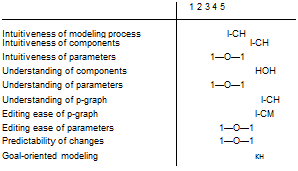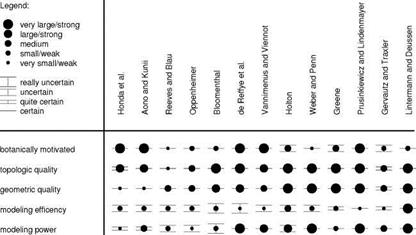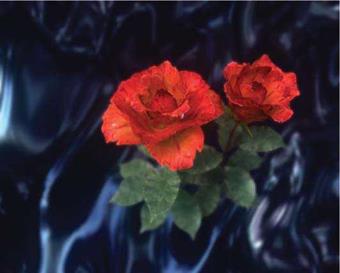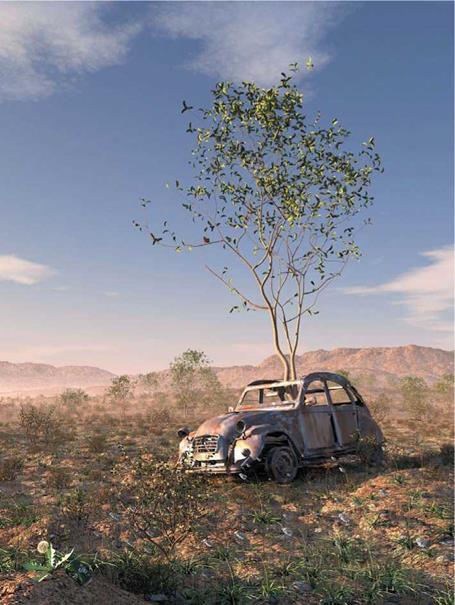Contrary to the many methods presented so far, rule-based object production permits a fast and intuitive modeling of plants. In order to support this statement, a small user study with 18 persons was conducted.
After a 10-minute briefing about the system, 10 people had to model the head of a sunflower within 30 minutes, and eight people were to complete a tulip within a 45-minute time span. The modeling task of the first group required more intensive work with the multiplication components, while the second group was confronted with geometrical modeling problems. In addition, during the test period, the participants were allowed to consult with the project leader, and both groups were given photographs of the objects to be modeled.
Figure 6.16 shows the results of the questioning following the experiment. All values are indicated as 90%-confidence intervals for a normal distribution. Despite the relatively large confidence intervals, the results prove that the system was judged to produce an intuitive, understandable, and easily edited representation of a plant.
 Figure 6.16 Evaluation of untrained users (1=bad/insufficient, 5=very good/high)
Figure 6.16 Evaluation of untrained users (1=bad/insufficient, 5=very good/high)
The p-graph is likewise very intuitive in its structure. However, the number and the comprehensibility of the parameters is sometimes a problem. Here the prominent problem of all modeling systems comes to light: the modeling power is nearly always accompanied with too many parameters.
Due to the varying approaches of the different plant modeling methods discussed in the last three chapters, it is relatively difficult to draw a clear comparison between the individual procedures. The techniques are evaluated therefore
on the basis of individual criteria that proved to be important in the practical work.
![]()
![]()
 |
 |
In the introduction we already addressed the various motives for the reproduction of plant morphology. Botanists are interested in the basic rule mechanisms, since the geometries of the models serve only for validating the production mechanisms or as basic data for the development of extended parameters such as the maximum utilization of light. For computer graphics the shape is the center of attention: “everything goes as long as it looks good”. This phrase allows us even to consciously generate botanically incorrect shapes, as long as the desired visual effect is obtained. In this sense both the botanical accuracy, and with it the question to what extent botanical effects were replicated, and the topological and geometrical quality of the representation are to be evaluated. Furthermore, in computer graphics the modeling aspect plays an essential role. It is crucial how quickly the user arrives at a desired shape. An important point of evaluation is thus the modeling effectiveness and in addition the modeling power that indicates what spectrum of plants can be produced. In Fig. 6.17 the evaluations are summarized.
Since the material for the individual procedures was presented in varying quality and quantity, additionally the accuracy of the evaluation was specified for each evaluation, i. e. the modeling effectivities of the procedures are indicated as relatively large uncertainties in nearly all cases, since only papers were used, and experimenting with the respective approaches was not possible. Unfortunately, the authors nearly never got involved in the indication of the modeling times.
The overall results, for all intents and purposes, reflects different strengths and weaknesses in the individual methods, which leads to the conclusion that these methods were designed for different purposes, and the focus shifted over time. The early procedures of Honda et al. as well as those of Aono and Kunii adhere to a purely botanic motivation; they attach importance to the modeling of
topology and neglect the geometrical aspects. In contrast, the subsequent work of Reeves and Blau, Oppenheimer and Bloomenthal place botany in the background, and the realistic appearance of the plants becomes the actual goal. De Reffye seems to have found a good compromise between a botanically motivated procedure and the necessary power of the approach.
Although the visual results of Vannimenus and Viennot are not really high quality, their combinatorial procedure is methodologically interesting and thus counterbalances the weaknesses in the representation. Holton pursues an interesting principle and moreover is also able to supply realistic pictures.
Weber and Penn consciously distance themselves from botanic regularities and model shapes of plants. The results are impressive, in particular since there also different degrees of detail can automatically be produced.
Certainly the most prominent method in connection with the modeling of plants is L-systems. With described extensions the group of Przemyslaw Prusinkie – wicz at the University of Calgary has succeeded in extending L-systems step by step, so that these are able to replicate almost all important processes of plant growth. The only weakness remaining is the less intuitive structure of the systems, at least insofar as structure and interaction of subsystems is concerned. It demands profound experience in order to be able to use L-systems efficiently. Rule-based object production seems to be a good compromise between the necessary modeling power and intuitivity of a practical approach. Though there is nothing that cannot be modeled using parametric L-Systems, the components of rule-based object production provide the typical user with an intuitive modeling strategy. Global and local manipulation methods enable the user to influence the shape of a plant efficiently. With a small number of components most plants on earth can be modeled – and much more. The examples on the following pages show some of the works that were done using the system.
|

|
|
Figure 6.20 “Evergreen” by Gilles Tran |
|
|
|







